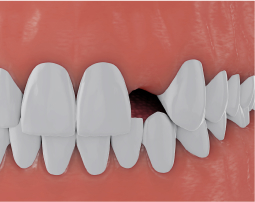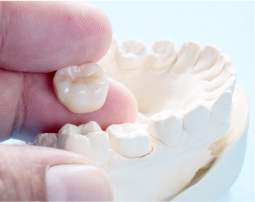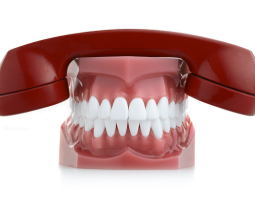Replacing Missing Teeth With Dental Implants
If one or more of your permanent teeth are missing, there are a number of ways to replace them. An alternative to bridges, partials or complete dentures may be dental implants. Implants are used to replace missing roots and support artificial replacement teeth. They are typically quite comfortable and look like natural teeth.
How Dental Implants Work
A dental implant is an artificial tooth root that is usually constructed from titanium, a biocompatible material that has been used for decades in hip and knee replacement surgeries. The implant is inserted into the jawbone, and the bone fuses with its rough surface in a process called osseointegration. Once the artificial tooth root is anchored into the jawbone, a tooth restoration is attached to the abutment, which is the part of the implant that extends from the top of the gums. Implants can be used to replace one or more teeth:
Single Tooth: In this simple procedure, a single implant is placed at the site of a lost tooth and is affixed with a porcelain crown.
Implant Bridge: A traditional bridge is attached by placing crowns on the healthy teeth on either side of the empty tooth sockets, but an implant bridge uses two or more titanium implants to anchor the restoration in place.
Implant Dentures: In cases where several or all teeth are missing, a few strategically-placed titanium implants can hold a full or partial denture in place.
Candidates For Dental Implants
In general, most people who are healthy enough to undergo a dental procedure such as a filling placement< or root canal therapy are good candidates for dental implants. You must have healthy teeth and gums, so any cavities or signs of periodontal disease must be addressed first. Tell your dentist if you have any chronic health conditions or are taking medications. These factors will not necessarily prevent you from receiving implants, but your dentist may need to take certain precautions during the procedure to ensure its success. You also need to have a sufficient amount of dense bone tissue to support an implant. However, if you have suffered bone loss, which is common after tooth loss, a bone grafting procedure can help rebuild the tissues.
The Dental Implant Procedure
Placing dental implants is a two-step procedure:
Implant Placement: This part of the process usually only requires local anesthesia, but your dentist can administer something a bit stronger if you feel anxious. Once you are comfortable, your dentist will create an opening in the gum tissues at the site of the missing tooth and then insert the small titanium rod into the jawbone. Your dentist will then close the gum tissues with a few sutures. The gums will heal in about a week, but you must wait several months for osseointegration of the implant to take place. You may be fitted with a temporary tooth restoration to wear while you are waiting.
Placing Restorations: When your implants are ready for permanent restorations, your dentist will take impressions of your mouth to create replacement teeth that blend well with your natural teeth. You will then return to have your restorations permanently affixed to your implant abutments.
Advantages Of Dental Implants
While other tooth-replacement methods are still in use today, dental implants are the gold standard for a reason. Dentures are designed to stay in place with suction or by attaching to your remaining teeth with clasps. While they may fit perfectly when you first receive them, the natural bone loss that occurs with missing teeth can make them lose their fit over time, causing patients to experience embarrassing slippage on a regular basis. Bridges are another common tooth replacement option, but they require the reduction of healthy tooth structure for crown placement. Implants do not pose any of these issues. Because your new restorations are permanently anchored into your mouth, you can enjoy speaking and eating without worrying about your teeth slipping out of place. In addition to helping you maintain the healthy structure of your remaining teeth, they look and feel just like your natural teeth and stimulate your jawbone to help preserve a youthful facial appearance.
Dental Implants 101: The Post
The post is a medical-grade titanium screw that serves as a root for your new teeth. The advantages of medical-grade titanium are that it doesn’t corrode and it has properties that help it fuse permanently with human bones. As an added bonus, modern dental implants now only require four posts to restore an entire arch.
Dental Implants 101: The Crown
The crown is the part of the tooth that you can see. It’s usually made of porcelain and is also fully customizable so you can design your perfect new smile. It’s also strong enough to allow you to bite into an apple or an ear of corn.
Dental Implants 101: The Abutment
The abutment is what holds the post and crown together. The connection created by the abutment reinforces the post and crown, making them even stronger and permanent (but removable by a doctor). The best part is that these begin supporting your new teeth the same day as your surgery.
Dental Implant Video
Dental Implant Faq’s
Get answers to common questions about dental implants. See our Dental Implant FAQ’s. As you explore your options, it is important to keep in mind that this is a lifetime investment, so quality treatment should largely outweigh any minor differences in price.
We would be happy to see you for an examination to determine if you are a good candidate for implant placement. We will review your medical history and go over treatment options and explain the stages of the process. We do refer out to a local oral surgeon to complete the surgery portion of the procedure. The restorative portion of the appointment where a crown is loaded onto your implant would be completed by our general dentists here at Ascent Family Dental.
Improve your oral health with Ascent Family Dentistry
Dental Solutions For You

Are you missing a tooh?

I have a broken tooth. Help!

I want to feel confident about my smile.

I’m in pain. What do I do?

My snoring is keeping everyone awake!

I have questions about dentures. Can you help?

But I’m afraid to visit a dentist!

My gums are bleeding. Something’s not right!

